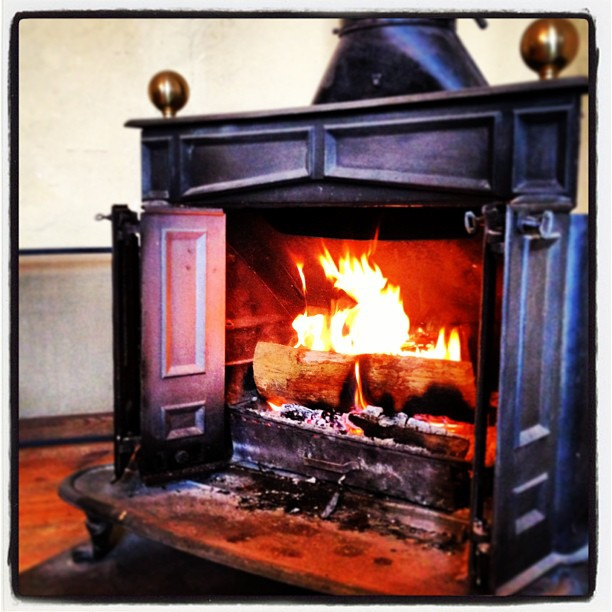The Benjamin Franklin stove stands as a testament to the innovative spirit of one of America’s founding fathers, blending practicality and ingenuity in the pursuit of comfort. Developed in the 18th century during a notably harsh winter, this remarkable invention enhanced the traditional Pennsylvania fireplace, allowing colonists to heat their homes more efficiently while using less wood. As historian Joyce Chaplin reveals in her insightful new book, the Franklin stove not only revolutionized heating technology but also contributed significantly to atmospheric science history. This climate adaptation technology reflects Franklin’s broader contributions to science, illustrating how his inventions have laid the groundwork for modern approaches to energy efficiency and environmental awareness. By exploring this lesser-known aspect of Franklin’s legacy, we can appreciate how his ideas continue to influence our understanding of technology and the environment today.
The Franklin stove, also referred to as a Pennsylvania fireplace, represents a pivotal advancement in home heating during the colonial era. This flatpack iron stove, designed for easy assembly, allowed people to maximize warmth while minimizing fuel consumption at a time when wood was increasingly scarce. In Joyce Chaplin’s work on Franklin, she emphasizes how this invention was not only a technological marvel of its time but also a vital part of the discourse surrounding climate challenges and air quality. By examining the intersections of history, technology, and environmental science, Chaplin unveils how Franklin’s creations, including this stove, resonate within the broader fabric of American innovation. Ultimately, the story of the Franklin stove illustrates the timeless quest for comfort and sustainability against the backdrop of evolving knowledge about our natural world.
The Franklin Stove: An Ingenious Invention
Benjamin Franklin’s stove, often referred to as the Pennsylvania fireplace, is a remarkable example of early American ingenuity. Developed during the harsh winter of 1740-1741, this innovative heating device was designed to enhance warmth in homes while utilizing less wood than traditional fireplaces. By understanding and applying principles of convection, Franklin created a stove that allowed heat to distribute evenly throughout a room, changing how early Americans viewed home comfort. The transition from wood to coal also marked a significant step toward more efficient heating solutions, showcasing how climate adaptation technology was evident in Franklin’s work.
Through his inventions, including the Franklin stove, Franklin not only addressed the immediate need for warmth but also contributed to the broader scientific discourse on atmospheric phenomena. This connection underscores the importance of interdisciplinary approaches to problem-solving in science; Franklin’s stove did not merely serve as a heat source. It became a tool for understanding air movement, influencing meteorological studies and eventually aiding in the mapping of critical atmospheric currents like the Gulf Stream, historical advancements that emphasize the interplay between invention and atmospheric science history.
The Role of Franklin’s Stove in Climate Adaptation
The significance of the Franklin stove extends beyond its practical heating capabilities; it represents an early response to environmental challenges. Historian Joyce Chaplin highlights that as the population grew in the American colonies, deforestation made firewood increasingly scarce, driving up costs and affecting the poor disproportionately. Franklin’s design was not only a scientific breakthrough but a socially conscious innovation aimed at improving life quality amidst climatic adversity. His understanding of the implications of deforestation foreshadowed contemporary discussions around sustainable resource management and climate adaptation strategies.
Franklin’s proactive approach to utilizing technology for addressing climate-related issues can be seen as a precursor to modern environmentalism. Each iteration of his stove was an effort to minimize emissions and maximize efficiency, reflecting his cognizance of urban air quality challenges, which resonate with today’s concerns regarding pollution. By rethinking conventional methods of heating, Franklin paved the way for future advancements in climate adaptation technology, illustrating how historical figures like him can inform current and future environmental policies.
Benjamin Franklin and the Science of Convection
In his exploration of atmospheric concepts, Benjamin Franklin introduced the principle of convection to the broader public. The design of the Franklin stove was grounded in his belief that warm air naturally rises. This understanding allowed him to create a heating system where warmth circulates effectively throughout a room, significantly improving indoor comfort. By educationally framing his discoveries in accessible terms, Franklin made complex scientific ideas relatable, which was pivotal for the emergence of atmospheric science as a discipline in American thought.
Franklin’s work exemplifies how innovations can elucidate natural phenomena. His pamphlet detailing the workings of the stove allowed average colonists to grasp essential scientific principles. This outreach signifies the interplay between invention and education, as Franklin aimed to cultivate a scientifically literate society. Consequently, the Franklin stove not only provided physical warmth but also stimulated intellectual curiosity about the natural world, laying foundational ideas that shaped the evolving field of atmospheric science history.
Reviving Historical Innovations for Modern Solutions
Joyce Chaplin’s examination of Franklin’s inventions, particularly the stove, serves as a reminder of the historical antecedents to today’s technological challenges. The Franklin stove, with its focus on efficiency and climate awareness, provides valuable insights for contemporary innovators seeking solutions to environmental issues. As we grapple with pollution and climate change, revisiting the successes and failures of historical inventions can reveal pathways to modern adaptations or entirely new approaches in the fight for sustainability.
Furthermore, the principles embodied in the Franklin stove—such as minimizing waste and optimizing energy use—remain relevant in discussions on developing energy-efficient technologies today. Innovators must recognize that the quest for effective climate adaptation technology is not merely about creating new devices but also about re-examining and enhancing existing technologies. By learning from the past, we can better navigate the complexities of modern environmental challenges and avoid falling into the trap of seeking a singular silver-bullet solution.
Understanding the Societal Impact of Franklin’s Innovations
Franklin’s inventions were not only technical wonders; they also had profound social implications that echo through time. By addressing the heating needs of households, the Franklin stove transformed daily life for many Americans, particularly in regions suffering from extreme cold. This focus on enhancing domestic comfort resonates in today’s quest for energy efficiency, where the primary goal often includes reducing costs while improving living conditions. Consequently, his contributions underscore how scientific advancements can drive social change, making innovations like the Franklin stove worthy of historical examination.
Moreover, as we reflect on Franklin’s life and inventions, we recognize the necessity for responsible practices in science and technology. The emergence of historical narratives, such as those presented by historian Joyce Chaplin, shed light on how Franklin engaged with societal expectations and natural resource management. This insight can inspire modern scientists and inventors to think critically and ethically about their contributions, emphasizing a balanced approach in harnessing technology to foster community welfare while minimizing environmental impacts.
Connecting Historical Innovations to Contemporary Issues
Joyce Chaplin’s work emphasizes the necessity of linking historical innovations, such as the Franklin stove, to contemporary environmental challenges. Franklin’s understanding of atmospheric science and his innovations to improve heating efficiency are particularly relevant as we confront global warming and urban air pollution today. His stove was not merely an issue of comfort; it represented a forward-thinking approach to energy consumption, an example we can learn from as we develop current technologies. Understanding how past inventions were created with climate adaptation in mind enables a more profound comprehension of our ongoing crises.
As today’s society seeks effective solutions to climate issues, looking back to Franklin’s legacy can provide valuable frameworks for innovation. The importance of balancing comfort with environmental responsibility finds expression in Franklin’s work, encouraging a milieu of creativity and accountability in today’s invention landscape. As we aspire to navigate the complexities of climate adaptation technology, Franklin’s stove symbolizes a keystone in the narrative of American technological progress, illustrating that the quest for improvement often emerges from the depths of necessity.
Benjamin Franklin: The Man Behind the Stove
Benjamin Franklin was a multifaceted figure whose contributions extended far beyond the invention of the Franklin stove. His life as a printer, scientist, statesman, and inventor reveals a character driven by intellect and curiosity. Franklin leveraged his humble beginnings in Pennsylvania to engage deeply with scientific inquiry, embodying the spirit of the Enlightenment era; his adventures in experimentation led him to significant breakthroughs in various fields. The Franklin stove is just one of his inventions, yet it encapsulates his broader vision of how technology could solve real-world problems while improving societal welfare.
Moreover, Franklin’s ingenuity was accompanied by a profound sense of social responsibility. The design of the stove was not simply an endeavor for personal achievement but rather a reflection of his awareness of communal needs during challenging times. As a historical figure, he represents the dynamic relationship between science, society, and the environment, which is crucial for understanding how we can harness innovation for public good today. By studying Franklin’s life and contributions, we are reminded of the intersection of invention and humanity in fostering a better world.
Lessons from Franklin for the 21st Century
The insights from Joyce Chaplin’s analysis of Benjamin Franklin’s inventions, particularly the Franklin stove, illuminate valuable lessons for today’s innovators and policymakers. Much like Franklin, who faced significant environmental challenges during his time, we are tasked with navigating a complex climate crisis marked by excessive emissions and resource depletion. His approach to innovation—emphasizing efficiency, sustainability, and social welfare—is relevant as we endeavor to find practical solutions to contemporary issues. The principles underlying the Franklin stove can guide us in developing technologies that prioritize both user comfort and environmental health.
Ultimately, Franklin’s legacy encourages a mindset of adaptability and thorough inquiry in the face of daunting challenges. By understanding that no single solution can resolve multifaceted problems, current and future generations can learn from Franklin’s iterative process of invention. The spirit of progress lies not only in the creation of new technologies but also in the context within which they are developed and deployed. Franklins’ example encourages a collaborative, multifaceted strategy that recognizes the need for diverse solutions to achieve significant, sustainable change in the climate adaptation technology landscape.
Frequently Asked Questions
What are the key features of the Benjamin Franklin stove?
The Benjamin Franklin stove, also known as the Pennsylvania fireplace, features a unique design made of iron plates that enhances heating efficiency by using less wood. It operates on convection principles, allowing warm air to rise and effectively heat entire rooms. This innovative stove was developed as a climate adaptation technology during the harsh winter of 1740, significantly improving the warmth of homes compared to standard fireplaces.
How did the Franklin stove contribute to atmospheric science history?
The Franklin stove advanced atmospheric science history by illustrating how convection works, both indoors and outdoors. Benjamin Franklin explained that the principles behind his stove—where warm air expands and rises—could also describe how storm systems, such as the Gulf Stream, travel along the Atlantic coast. By making these connections, he made scientific concepts more accessible to the public, proving the stove’s importance beyond just heating.
Who is Joyce Chaplin and what is her contribution to Benjamin Franklin studies?
Joyce Chaplin is a historian and the James Duncan Phillips Professor of Early American History. She has significantly contributed to Benjamin Franklin studies through her intellectual biography and her recent book, ‘The Franklin Stove: An Unintended American Revolution.’ In her latest work, she explores Franklin’s lesser-known inventions, including the stove, and connects them to broader themes of climate adaptation technology and atmospheric science.
Why is the Franklin stove considered a climate adaptation technology?
The Franklin stove is regarded as a climate adaptation technology because it was designed during a period of extreme cold, specifically the Little Ice Age. It provides greater warmth while using less wood, addressing the challenges of fuel scarcity faced by early American settlers. This invention reflects Franklin’s foresight in using science and technology to improve human comfort in response to environmental challenges.
What were Benjamin Franklin’s intentions behind minimizing emissions from his stove?
Benjamin Franklin aimed to minimize emissions from his stove because he was concerned about air pollution in cities like London. His later designs included features to reburn smoke, redirecting it back into the fire for efficiency. This approach not only conserved fuel but also reduced pollutants, highlighting Franklin’s early recognition of the health risks associated with smoke emissions.
How can the Franklin stove inform current discussions on climate technology?
The Franklin stove can inform current discussions on climate technology by exemplifying the need for multifaceted solutions to climate challenges. Joyce Chaplin’s book suggests that, like Franklin, modern innovators should be cautious about relying on single solutions such as quick engineering fixes. Instead, a combination of approaches is required to effectively address climate change while learning from historical innovations.
What impact did Benjamin Franklin’s stove have on heating technology?
The impact of the Benjamin Franklin stove on heating technology was profound, as it inspired numerous innovations in heating systems. By demonstrating the principles of convection and efficiency, it laid the groundwork for future heating designs, improving indoor climate control and influencing how homes are heated even today.
What were the social implications of the Franklin stove for early American society?
The social implications of the Franklin stove for early American society included enhanced comfort and improved living conditions, especially during harsh winters. This invention emphasized Franklin’s awareness of deforestation and fuel accessibility issues, ultimately aiming to provide warmth for all, regardless of socio-economic status. His design represented a significant leap towards creating a more equitable living environment.
| Aspect | Details |
|---|---|
| Invention | Benjamin Franklin stove, a flatpack iron design to enhance heating. |
| Context | Developed during a harsh winter (1740-1741) as a climate adaptation due to rising firewood costs. |
| Design Efficiency | Utilizes principles of convection to heat rooms more effectively while using less wood. |
| Innovative Impact | Helped advance understanding of atmospheric phenomena, such as the Gulf Stream. |
| Societal Context | Evolved from concerns about deforestation and the accessibility of firewood for the poor. |
| Environmental Awareness | Franklin aimed to reduce air pollution by recycling smoke through the stove’s design. |
| Legacy | The Franklin stove is now viewed as a significant aspect of Franklin’s scientific contributions. |
Summary
The Benjamin Franklin stove exemplifies the ingenuity of Franklin’s inventions, showcasing his ability to merge practicality with scientific insight. Developed during an era of severe climate challenges, Franklin’s stove not only addressed the immediate need for efficient heating but also contributed to the broader understanding of atmospheric science. As we continue to navigate today’s environmental issues, reflecting on Franklin’s innovative spirit can inspire modern solutions to our ongoing climate crisis.








